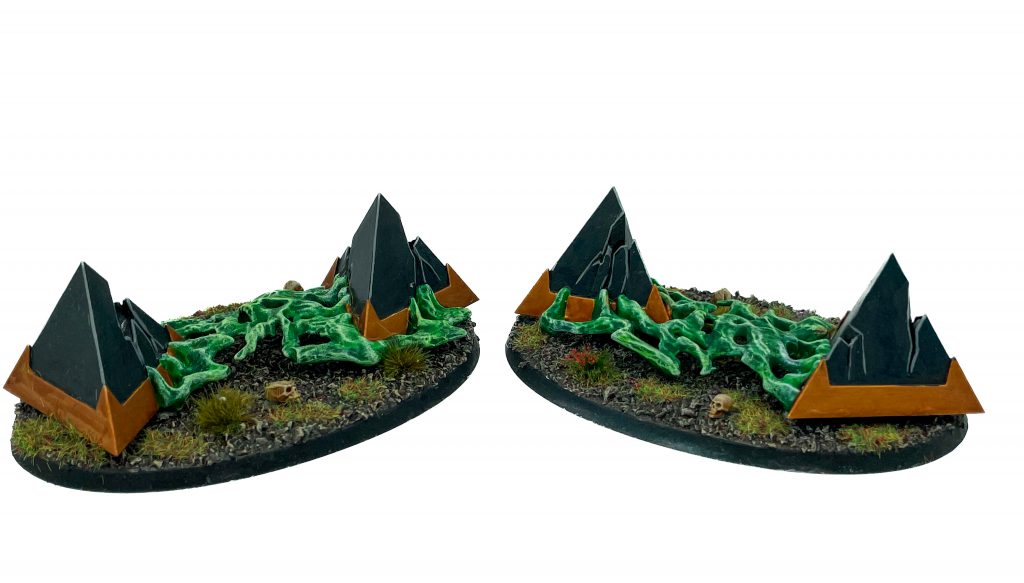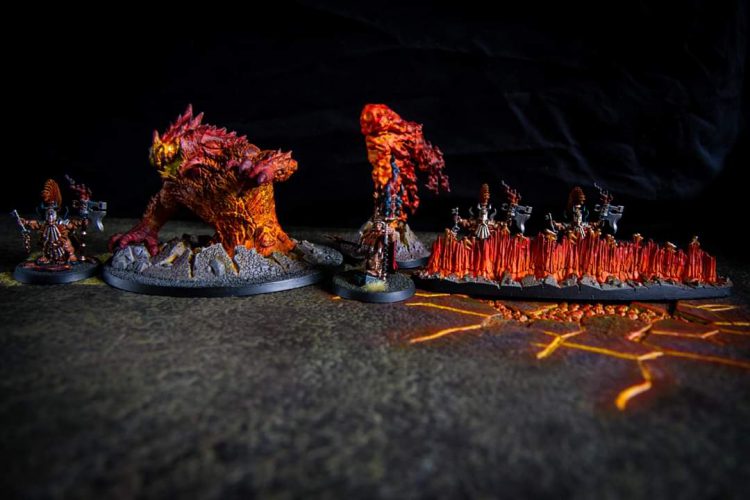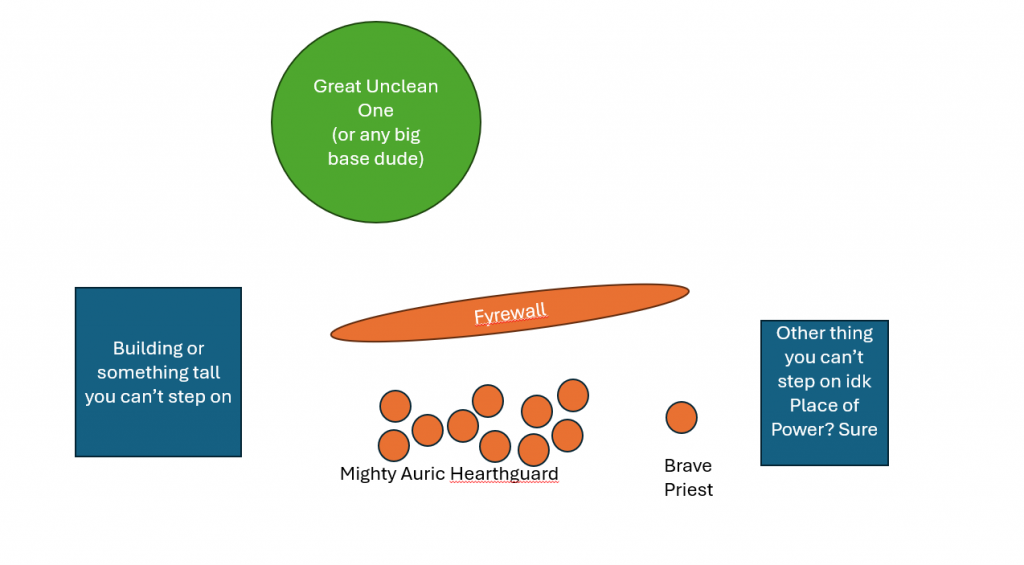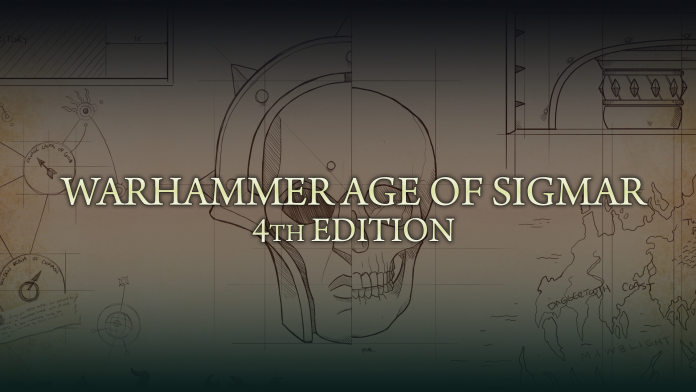It’s a whole new edition of Age of Sigmar which means a few things: veteran players assume rules that aren’t there any more, new players are confused by the confusion of veteran players, and for a few months everyone is figuring what’s good or not. If you haven’t seen, we’ve already covered a lot about the new edition and will continue to with more in-depth looks at armies as we collectively get to play more games.
Today, however, is a topic that I’ve seen crop up across Discord servers, Whatsapp group chats, Facebook pages, and yes even Reddit posts: manifestations and how the hell they actually work. Previously I reviewed the generic options and talked a little bit about how they work, but today is an in-depth cover-it-all Ruleshammer. Classic.
The Basics
What is a manifestation you might ask? These are what used to be called Endless Spells and Invocations. They still are, kind of, and expect those names to stick around for a while. You get to pick a “manifestation lore” as part of your army construction and most armies can choose one from their own faction pack or one of the generic lore options. There are a couple ways of having access to more than one lore but that’s extremely limiting so I’ll talk about that at the bottom.
Above all else manifestations are not units. Sometimes the are treated as if they were units, are effected by things that would effect units, but at the end of the day they are not.
All units, friendly and enemy, are able to move through manifestations but cannot end with their base overlapping a manifestation. At a glance or first thought that might sound terrible and like “well what’s the point?” but consider how large the bases of many of these are and you’ll soon realise that you can, actually, control quite a lot of movement and how many enemy attacks will be swinging in at you. This will take a bit of practice on the table. Try setting up some units on your kitchen table at home and see what I mean.
Manifestations are split down into two basic categories: ones that can move and ones that cannot. Any of these that have a movement value listed as ‘-‘ cannot move and follow a slightly different set of rules. Throughout the article I’ll simply be referring to these as manifestations that can move or that can’t move.

Credit: AoS Coach
Summoning and Banishing (or Just Killing)
To bring them onto the table you’ll need either wizards or priests to summon them. Some manifestations are spells and need to be summoned by wizards, the specific one that you want to summon will give you a target casting number to equal or beat and tell you how to set it up on the table. Others instead need priests with a target chant value. In either case setting them up is simple:
- If they can move they have to be set up more than 9″ from enemy units and cannot move in the same turn. They can charge later in the turn, however.
- If they cannot move then they can be set in any proximity to enemy units, just within the summoning range of the caster/chanter (typically wholly within X inches)
You can attempt to summon one during your opponent’s turn using the Magical Intervention command. That happens after your opponent has used all of their own hero phase abilities and very importantly after they have the chance to banish any manifestations. They can still attempt to unbind one summoned by a wizard but can’t do anything about one summoned by a priest!
To get rid of them you have a few options. Priests and Wizards are allowed to use the Banish Manifestation ability during your own hero phase. That’s only during your own hero phase, not your opponents. You can only attempt to banish the same manifestation oncer per hero phase and have to be within 30″ of it. You roll 2D6 and have to equal or beat the banishment roll on that manifestation’s warscroll and 7+ seems to be the most common. It does come at a cost however since it will use up one of your casts or chants for that turn. A Wizard/Priest (1) can either attempt to banish or cast while a Wizard/Priest (2) could attempt a banishment and still cast/chant once.
Option two is killing them outright. All manifestations have a health characteristic and save value. You’re allowed to charge and attack your opponent’s manifestations as if they were units and they typically go down pretty quick; just keep in mind that that’s a bunch of attacks not going into enemy units! If it’s a manifestation with multiple pieces like the shards then you just need to kill off one and they all disappear.
Option three is simply killing the wizard or priest that summoned it! This means there’s a small amount of book keeping necessary so you know which wizard/priest summoned which manifestation so that if/when they die the manifestation is also removed from the board.
What They Can Do
As I said manifestations are not units except for seven bullet points outlining when they act like units. The sixth one got a day one FAQ too!
All of them:
- Can be picked by any enemy abilities but not by enemy abilities that do not involve choosing a target
- If they have any melee or ranged weapons can use Fight and Shoot Core abilities as appropriate to the weapon
- Enemies can end a charge move within 1/2″ of them
- Models can move through them but not finish a move on top of them
Ones that can move:
- Count as a unit for purposes of movement, combat ranges, being in combat, and setting up other units (ie opponent cannot be set up within 9″ of them if they cannot be set up within 9″ of enemy units, the most common range for arriving reserves)
- Use Move Core abilities (that covers Normal Move, Retreat, Run, and any they may have of their own)
Ones that cannot move:
- Only count as an enemy unit during the Combat phase (FAQ’d to be only Combat phase) for purposes of movement, combat range, being in combat, and setting up other units
That last point is crucial because it means that those move ‘-‘ manifestations are incapable of locking units into combat; enemies do not have to retreat from them and can charge away from them freely!
On the other hand enemy units can be set up within 9″ of them (even in base contact of them if the player wants and there aren’t any other units stopping them from doing so) potentially giving away much easier charges out of reserves. With 3″ pile in and 3″ combat range that can bring enemy units into combat of units you thought were safe off of very small charges so be careful with your placement!
What They Cannot Do
- Use commands (any of them!)
- Benefit from any of your own abilities that effect friendly units
- Contest objectives
- Finish a move within combat range of units during the movement phase (unless specifically stated and one weird edge case)
That last one is a little funny because some manifestations like the Purple Sun have their own Core Move ability which don’t have the same wording as Normal Move or Run. They do, however, have the Fly keyword which as a Passive effect stopping them from ending within combat range.
I might say it a few times: manifestations are not units! They do not benefit from any of your factions abilities. It doesn’t matter if they have the right faction keywords, they’re not units and so do not benefit from any abilities. Your opponent is specifically allowed to target them with abilities but even passive de-buffs from your opponent that don’t target units won’t effect them either such as the Gloomspite Gitz Endless spell which is a 12″ wholly-within aura for enemy units to suffer -1 from hit rolls. That won’t effect a manifestation’s attacks.

Placement is Key
This might sound obvious but as with any unit from your army where you place these will entirely determine how useful or good they are for you.
As above the ones that cannot move are able to give away easy charges for your opponent! Make sure that you have more than 3″ of space between your manifestations and your units so that you aren’t getting pulled into combat off of those easy charges.
Priests have the best time with manifestations right now. You can “attempt” to chant a prayer in your own turn and bank those ritual points so that you can summon a move ‘-‘ manifestation in a very annoying spot. The -1 on the roll won’t typically matter since you’re adding ritual points to the roll; just don’t roll a 1, easy! For example a Fyreslayer priest can summon in a fyrewall in front of some of your units. Enemies can move through it, sure, but they can’t end on top of it. That can make it much more difficult for larger bases or larger units of smaller bases from getting to your unit if you can set that up well between terrain and your units.
Warning: graphic not quite to scale. I made it in Powerpoint. This is not my strong suit, ok?

I have had this, basically exact, thing come up in game though that’s why I’m illustrating it. My Auric Hearthguard were about to be removed by that Great Unclean One…until I summoned in a Fyrewall during his hero phase. My priest had failed a chant the turn before with the roll of a 2 (so a 3 with the place of power bonus) and was able to use those ritual points to just about guarantee the summon. The Great Unclean One is able to move through the manifestation but there’s nowhere for his base to fit now, so he can’t! He can charge the Fyrewall of course and waste a turn beating it to death but that still leaves me with Auric Hearthguard alive before going into my turn.
Oddball Stuff
This wouldn’t be a wargame if there weren’t some odd interactions.
Getting back on the above about weird edge cases on movement:
Some manifestations, the Purple Sun being a prime example, have their own Core Move ability which doesn’t have the same stipulation about ending their move within combat range. They do still have the Fly keyword which has a Passive effect adding that back in. So we end up in about the same place but a roundabout way to get there. However, if your opponent somehow has an ability that would remove Fly from the Purple Sun (remember it has to be chosen as a target, so the Shards won’t do it) it would then be able to move into combat with units during its own, weird, move ability.
The Krondspine. Still weird. It is a manifestation that eats manifestations. It charges them from further away and heals when it destroys them. It’s also one of few, alongside the Purple Sun, that is semi-immune to being banished. If it were to be banished it instead just suffers a bunch of damage; since you can’t target it with multiple banishments in the same hero phase it’s immune to being one-shot on a lucky roll. That damage will absolutely help remove it of course, but it’s much less useful than just picking it up immediately!
Some units are able to interact with manifestations outside of the normal ways. Archaon’s Tzeentch rampage is one example where instead of making a Banish Manifestation roll he can simply remove a manifestation from the table within 12″ of him and deal some mortal damage to its caster. That ability also bypases the above and will absolutely just pick up a Krondspine or Purple Sun on a single 2+ roll. That’s because while it is “banishing” the manifestation it’s not using the “Banish Manifestation” ability. Fun.
Free to Play
Honestly I have mixed feelings about manifestations. One on hand I think they’re very cool. I loved when they came out back during second edition and always wished you saw more of them being taken in lists and put on the table. Now they don’t cost you any points so not taking them actively feels like a disadvantage. Some armies aren’t even able to take them without bringing a Regiment of Renown or taking a specific artefact which can really make them feel like they’re playing at an automatic disadvantage.
In a rules set that feels incredibly clean manifestations stick out like a sore thumb. It makes me wonder if at one point they simply were just units while the edition was being written but it produced too many issues. Regardless of how we got here this is where we are and it will easily be the most difficult part of the game to get to grips with. I would strongly recommend any brand new players just skip them for their first few games on both sides of the table and add them a bit later.
Which manifestations are you eyeing up the most? Which ones have you found the most useful, or lacklustre?
Have any questions or feedback? Drop us a note in the comments below or email us at contact@goonhammer.com. Want articles like this linked in your inbox every Monday morning? Sign up for our newsletter. And don’t forget that you can support us on Patreon for backer rewards like early video content, Administratum access, an ad-free experience on our website and more.


